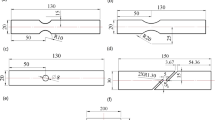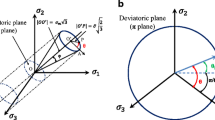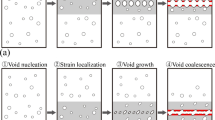Abstract
Prediction of the fracture is one of the challenging issues which gains attention in sheet metal forming as numerical analyses are being extensively used to simulate the process. To have better results in predicting the sheet metal fracture, appropriate ductile fracture criterion (DFC), yield criterion and hardening rule should be chosen. In this study, the effects of different hardening models namely isotropic, kinematic and combined hardening rules on the various uncoupled ductile fracture criteria are investigated using experimental and numerical methods. Five different ductile fracture criteria are implemented to a finite element code by the user subroutines. The criterion constants of DFCs are obtained by the related experimental tests. The in-plane principle strains obtained by the finite element analyses for different DFCs are compared with the experimental results. Also, the experimental results are used to evaluate the principle strain values calculated by the finite element analysis for different combinations of DFCs and hardening rules. It is shown that some DFCs give better predictions if the appropriate hardening model is employed.







Similar content being viewed by others
References
Keeler SP (1963) Plastic instability and fracture in sheet stretched over rigid punches. ASM Trans Q 56:25–48
Yoshida K, Kuwabara T, Kuroda M (2007) Path-dependence of the forming limit stresses in a sheet metal. Int J Plas 23:361–384. doi:10.1016/j.ijplas.2006.05.005
Hongsheng L, Yuying Y, Zhongqi Y, Zhenzhong S, Yongzhi W (2009) The application of a ductile fracture criterion to the prediction of the forming limit of sheet metals. J Mat Proc Tech 209:5443–5447. doi:10.1016/j.jmatprotec.2009.04.020
Freudenthal FA (1950) The inelastic behavior of engineering materials and structures. Wiley, New York
Cockroft MG, Latham DJ (1968) Ductility and workability of metals. J Inst Metall 96:33–39
Brozzo P, Deluca B, Rendina R (1972) A new method for the prediction of formability limits of metal sheets. In: Sheet Metal Forming and Formability, Proceedings of the Seventh Biennial Congress of International Deep Drawing Research Group, Amsterdam, Netherlands
Oh SI, Chen CC, Kobayashi S (1979) Ductile fracture in axisymmetric extrusion and drawing. J Eng Ind Trans ASME 101:36–44. doi:10.1115/1.3439471
Ayada M, Higashino T, Mori K (1984) Central bursting in extrusion of inhomogeneous materials. In Proceedings of the First ICTP. Adv. Tech. of Pals. Tokyo, Japan. 1:553–558
Kim N, Oh C, Kim Y, Yoon B, Ma Y (2011) Comparison of fracture strain based ductile failure simulation with experimental results. Int J Press Vessel Piping 88:434–447. doi:10.1016/j.ijpvp.2011.07.006
Hodge PJ (1977) Automatic piecewise linearization in ideal plasticity. Comput Methods Appl Mech Eng 10:249–272. doi:10.1016/0045-7825(77)90072-X
Hollomon JH (1945) Tensile deformation. Tram AIME 162:268–290
Prager W (1956) A new method of analyzing stress and strains work-hardening plastic solids. J Appl Mech 23:493–496
Lemaitre J, Chaboche L (1990) mechanic of solid materials, Cambridge university press, U.K., Ch.6.
Hibbit K, Sorensen Inc (2002) ABAQUS/Explicit User’s Manual, Version 6.3
Nakazima K, Kikuma T, Hasuka K (1968) Study on the formability of steel sheets. Yamata Techn Rep 264:141–154
Author information
Authors and Affiliations
Corresponding author
Rights and permissions
About this article
Cite this article
Abbasnejad Dizaji, S., Darendeliler, H. & Kaftanoğlu, B. Effect of hardening models on different ductile fracture criteria in sheet metal forming. Int J Mater Form 9, 261–267 (2016). https://doi.org/10.1007/s12289-014-1188-5
Received:
Accepted:
Published:
Issue Date:
DOI: https://doi.org/10.1007/s12289-014-1188-5




